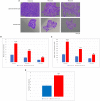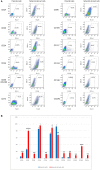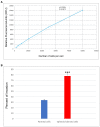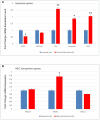Spheroid-Derived Cells From Renal Adenocarcinoma Have Low Telomerase Activity and High Stem-Like and Invasive Characteristics
- PMID: 31921617
- PMCID: PMC6915099
- DOI: 10.3389/fonc.2019.01302
Spheroid-Derived Cells From Renal Adenocarcinoma Have Low Telomerase Activity and High Stem-Like and Invasive Characteristics
Abstract
Cancer stem cells (CSCs) are a theorized small subpopulation of cells within tumors thought to be responsible for metastasis, tumor development, disease progression, treatment-resistance, and recurrence. The identification, isolation, and biological characterization of CSCs may therefore facilitate the development of efficient therapeutic strategies targeting CSCs. This study aims to compare the biology and telomerase activity of CSCs to parental cells (PCs) in renal cancer. Renal CSCs were enriched from the ACHN cell line using a sphere culture system. Spheroid-derived cells (SDCs) and their adherent counterparts were compared with respect to their colony and sphere formation, expression of putative CSC markers, tumorigenicity in non-obese diabetic/severe combined immunodeficiency (NOD/SCID) mice, and invasiveness. The expression of genes associated with CSCs, stemness, EMT, apoptosis, and ABC transporters was also compared between the two populations using quantitative real-time PCR (qRT-PCR). Finally, telomerase activity, hTERT expression, and sensitivity to MST-312, a telomerase inhibitor, was investigated between the two populations. We demonstrated that a subpopulation of ACHN cells was capable of growing as spheroids with many properties similar to CSCs, including higher clonogenicity, superior colony- and sphere-forming ability, and stronger tumorigenicity and invasiveness. In addition, SDCs demonstrated a higher expression of markers for CSCs, stemness, EMT, apoptosis, and ABC transporter genes compared to PCs. The expression of hTERT and telomerase activity in SDCs was significantly lower than PCs; however, the SDC population was more sensitive to MST-312 compared to PCs. These findings indicate that the SDC population exhibits stem-like potential and invasive characteristics. Moreover, the reduced expression of hTERT and telomerase activity in SDCs demonstrated that the expressions of hTERT and telomerase activity are not always higher in CSCs. Our results also showed that MST-312 treatment inhibited SDCs more strongly than PCs and may therefore be useful as a complementary targeted therapy against renal CSCs in the future.
Keywords: MST-312; cancer stem cells; hTERT; renal cell carcinoma; telomerase activity.
Copyright © 2019 Saeednejad Zanjani, Madjd, Rasti, Asgari, Abolhasani, Tam, Roudi, Mælandsmo, Fodstad and Andersson.
Figures









Similar articles
-
SMAD4 Expression in Renal Cell Carcinomas Correlates With a Stem-Cell Phenotype and Poor Clinical Outcomes.Front Oncol. 2021 May 3;11:581172. doi: 10.3389/fonc.2021.581172. eCollection 2021. Front Oncol. 2021. PMID: 34012911 Free PMC article.
-
The Pinx1 Gene Downregulates Telomerase and Inhibits Proliferation of CD133+ Cancer Stem Cells Isolated from a Nasopharyngeal Carcinoma Cell Line by Regulating Trfs and Mad1/C-Myc/p53 Pathways.Cell Physiol Biochem. 2018;49(1):282-294. doi: 10.1159/000492878. Epub 2018 Aug 23. Cell Physiol Biochem. 2018. PMID: 30138944
-
MicroRNA-34a regulates epithelial-mesenchymal transition and cancer stem cell phenotype of head and neck squamous cell carcinoma in vitro.Int J Oncol. 2015 Oct;47(4):1339-50. doi: 10.3892/ijo.2015.3142. Epub 2015 Aug 31. Int J Oncol. 2015. PMID: 26323460
-
Correlation between telomerase and mTOR pathway in cancer stem cells.Gene. 2018 Jan 30;641:235-239. doi: 10.1016/j.gene.2017.09.072. Epub 2017 Oct 24. Gene. 2018. PMID: 29074462 Review.
-
Cancer Stem Cells: Acquisition, Characteristics, Therapeutic Implications, Targeting Strategies and Future Prospects.Stem Cell Rev Rep. 2019 Jun;15(3):331-355. doi: 10.1007/s12015-019-09887-2. Stem Cell Rev Rep. 2019. PMID: 30993589 Review.
Cited by
-
Impact of PIN1 Inhibition on Tumor Progression and Chemotherapy Sensitivity in Colorectal Cancer.J Gastrointest Cancer. 2022 Jun;53(2):299-310. doi: 10.1007/s12029-021-00600-6. Epub 2021 Feb 13. J Gastrointest Cancer. 2022. PMID: 33580870
-
3D Tumor Models in Urology.Int J Mol Sci. 2023 Mar 25;24(7):6232. doi: 10.3390/ijms24076232. Int J Mol Sci. 2023. PMID: 37047203 Free PMC article. Review.
-
Low level expression of human telomerase reverse transcriptase predicts cancer-related death and progression in embryonal carcinoma.J Cancer Res Clin Oncol. 2020 Nov;146(11):2753-2775. doi: 10.1007/s00432-020-03319-2. Epub 2020 Jul 17. J Cancer Res Clin Oncol. 2020. PMID: 32681293 Free PMC article.
-
Exploration of the cancer genome atlas database reveals genes of interest related with cancer cell stemness indices in clear cell renal cell carcinoma.Heliyon. 2022 Nov 23;8(12):e11794. doi: 10.1016/j.heliyon.2022.e11794. eCollection 2022 Dec. Heliyon. 2022. PMID: 36471843 Free PMC article.
-
Circ_0005615 Regulates the Progression of Colorectal Cancer Through the miR-873-5p/FOSL2 Signaling Pathway.Biochem Genet. 2023 Oct;61(5):2020-2041. doi: 10.1007/s10528-023-10355-3. Epub 2023 Mar 15. Biochem Genet. 2023. PMID: 36920708
References
LinkOut - more resources
Full Text Sources

